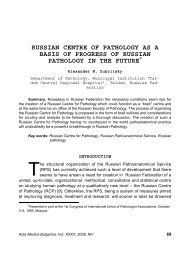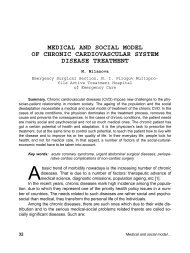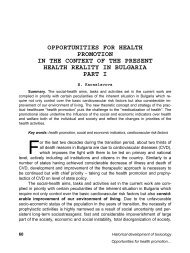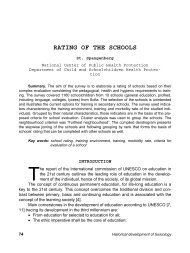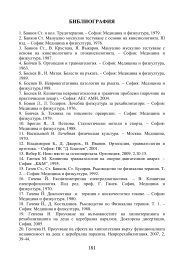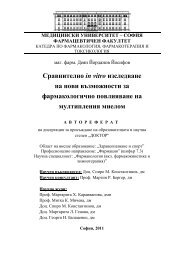Литературен преглед
Литературен преглед
Литературен преглед
Create successful ePaper yourself
Turn your PDF publications into a flip-book with our unique Google optimized e-Paper software.
36. Council Recommendation on patient safety, including the prevention and control of<br />
healthcare associated infections. (2009). http://eur-lex.europa.eu/bg/index.htm (April,<br />
2010).<br />
37. Cozens, J., N. Redfern, F. (2004). Confronting errors in patient care: the experiences<br />
of doctors and nurses. Clinical Risk 10: 184–190.<br />
38. Danish Society for Patient Safety. (2005). Patient Safety in Denmark: Past, current and<br />
future activities.<br />
39. Department of Health [UK]. (2001). Building a Safer NHS for Patients: Implementing<br />
An Organization with a Memory. London: Department of Health.<br />
www.doh.gov.uk/buildsafenhs.<br />
40. Dimenstein, I. (2008). Root Cause Analysis of Specimen Misidentification in Surgical<br />
Pathology Accession and Grossing. LABMEDICINE. Volume 39 Number 8. pp. 497-<br />
502.<br />
41. Donabedian, A. (2005). Evaluating the Quality of Medical Care. Blackwell Publishing.<br />
The Milbank Quarterly, Vol. 83, No. 4, 2005 (pp. 691–729).<br />
42. Dovey, S.M., R.L.Phillips. (2004). What should we report to medical error reporting<br />
systems? Qual. Saf. Health Care 13: 322-323.<br />
43. Dracup, K., C. Brown. (2005). First, do no harm. Аmerican journal of critical care,<br />
March 2005, Volume 14, No. 2. pp. 99-101.<br />
44. Drosler, S. (2008). Facilitating cross national comparisons of indicators for patient<br />
safety at the health system level in the OECD countries. OECD Health Technical<br />
Papers.<br />
45. Edmondson, A., (2004). Learning from failure in health care: frequent opportunities,<br />
pervasive barriers. Qual. Saf. Health Care 2004; 13; 3-9.<br />
46. Espinosa, J., T. Nolan. (2000). Reducing errors made by emergency physicians in<br />
interpreting radiographs: longitudinal study. BMJ 320: 737-740.<br />
47. ESQH. (2010). Patient Safety Culture instruments used in Member States.<br />
www.esqh.net (April, 2010).<br />
48. Everdingen van J.J.E., SM Smorenburg, W Schellekens, S Cucic. (2007). Patient<br />
Safety Toolbox: instruments for improving safety in health care organizations. Bohn<br />
Stafleu van Loghum.<br />
49. Fleming, M. (2005). Patient Safety Culture Measurement and Improvement: A "How<br />
To" Guide. Healthcare Quarterly Vol. 8 Special Issue.<br />
http://www.longwoods.com/product.php?printable=Y&productid=17656&cat=399&p<br />
age=1 (Last accessed on Oct 5 th , 2006).<br />
50. Fleming, M., N. Wentzell. (2008). Patient Safety Culture Improvement: Development<br />
and Guidelines for use. Healthcare Quarterly Vol. 11 Special Issue.<br />
51. Fletcher, M. (2000). The Quality of Australian Health Care: Current Issues and Future<br />
Directions. www.health.gov.au. (Аccessed on Sept 19 th , 2006).<br />
52. Flin R, C. Burns, K. Mearns, S. Yule, EM. Robertson. (2006). Measuring safety<br />
climate in health care. Qual Saf Health Care. 15, 109 – 115.<br />
53. Gaba, D. (2000). Anaesthesiology as a model for patient safety in health care. BMJ<br />
320: 785-788.<br />
157







